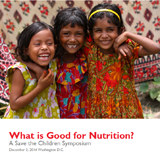
Investments and interest in nutrition have been continuing to grow since the release of The Lancet’s Series on Maternal and Child Nutrition in 2008 and 2013, the launch and spread of the Scaling up Nutrition movement, and the increased recognition of the impact of malnutrition worldwide. On December 3, 2014 Save the Children hosted a technical symposium ‘What is Good for Nutrition?
The one-day symposium provided an opportunity to discuss how we measure the impact of nutrition programs; the direction of nutrition programming in the future and; and highlighted some of the lessons from Save the Children’s USAID bilateral nutrition programs, FHI 360’s Alive & Thrive program, and the global USAID SPRING project. The Symposium proved an opportune moment for the nutrition community in Washington D.C to come together and discuss the future of programming building on the momentum of ICN2, the recently released Global Nutrition Report, and the USAID Multi Sectoral nutrition strategy. The Vice President for the Department of Health and Nutrition, Robert Clay opened the meeting, and pointed to the importance of reflecting on where the field of nutrition is now and from where we have come, its growing interest and importance, and the shift from looking at specific interventions to the more comprehensive approaches that are now being engaged in to improve nutrition. Robert reminded the audience of the need to be more vigilant about taking the advantage of this window of opportunity for nutrition, to focus on delivering results and build on the momentum of what has been learned so far.
A Key Note Address ‘Growing Children, Nutrition and Expectations for Impact of Interventions’ 1was delivered by Edward A. Frongillo, Jr., Ph.D., a Professor and Chair of the Department of Health Promotion, Education, and Behavior in the Arnold School of Public Health at the University of South Carolina. In this presentation, Dr. Frongillo presented data and innovative ideas and approaches to measuring child growth in interventions and discussion of what the Nutrition community and multi-sectoral partners should be focusing on in future design of programs.
Key messages
- There is a need for a holistic approach to child nutrition, it’s not just about stunting prevention. We ought to focus on healthy environments and well- being for children through to adolescence, and to ensure growth and development.
- Stunting may not be the most useful way to understand nutritional outcomes. It’s great for measuring changes over time, and regional differences, but not always appropriate to measure nutrition outcomes in interventions.
- We need to use a broad set of ECD measures and indicators to assess impact of interventions on children.
- Growth deficits continue after the 1000 days period, but better to measure this through the Height- for-Age difference (HAD) measured in centimeters rather than Z-scores.
The key note address was followed by an engaging panel discussion with leaders in the field of public health nutrition. Facilitated by the Save the Children Senior Director for Nutrition, Karin Lapping, questions addressed the direction of nutrition programming, the rise and role of convergence in funding, projects and partners, the presence of Nutrition in the Sustainable Development goals and how we can utilize the renewed focus on nutrition to deliver interventions at scale. The panelists were:
- Ellen Piwoz, Senior Program Officer, Nutrition Division at the Bill and Melinda Gates Foundation
- Rolf Klemm, Vice President of Nutrition, Hellen Keller International
- Jef Le Roy, Senior Research Fellow, International Food Policy Research Institute
- Anne Peniston, Chief, Nutrition Division at the Bureau of Global Health, USAID
- Leslie Elder, Senior Nutrition Specialist, Health, Nutrition and Population Unit of the World Bank